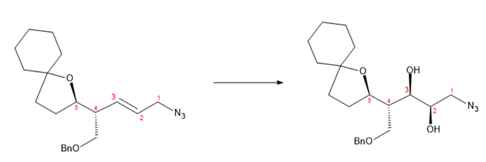11. Isofagomine is a non-natural product design and synthesized in 1994, which inhibits the activity or veral enzymes. Recently, an asymmetric synthesis was reported (Kulkarni Tetrahedron: Asymmetry 2012, 1234). One of the intermediates in Kulkarny's synthesis is a diol, synthesized by a dinydroxyklation of an alcohol as it's shown in the reaction scheme. The reaction is carried out in the presence of a catalysts under the conditions indicated. Assign the stereochemistry to the new chiral centers produced after the dihydroxylation and tell where the addition took place in each of the two carbons in the double bond of the substrate (Re/Si face). AD mix-B, 1:1 BUOH/H2O, 0 °C/12h OH N3 N3 Wort a BnO ÕH BnO
Catalysis and Enzymatic Reactions
Catalysis is the kind of chemical reaction in which the rate (speed) of a reaction is enhanced by the catalyst which is not consumed during the process of reaction and afterward it is removed when the catalyst is not used to make up the impurity in the product. The enzymatic reaction is the reaction that is catalyzed via enzymes.
Lock And Key Model
The lock-and-key model is used to describe the catalytic enzyme activity, based on the interaction between enzyme and substrate. This model considers the lock as an enzyme and the key as a substrate to explain this model. The concept of how a unique distinct key only can have the access to open a particular lock resembles how the specific substrate can only fit into the particular active site of the enzyme. This is significant in understanding the intermolecular interaction between proteins and plays a vital role in drug interaction.

The given reaction results in the following transformation of the molecule,

The product has two new chiral centers.
Step by step
Solved in 3 steps with 2 images









